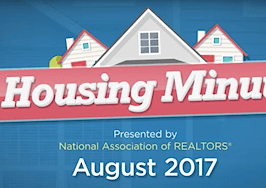- A rundown of pending home sales, existing home sales, price indices and studies from NAR, S&P Dow Jones, Zillow and Trulia.
Every month, economists release a number of indices, reports and analyses of the housing market, and it can be difficult to keep up with them all.
Thankfully, the National Association of Realtors (NAR) recapped the month in its new Housing Minute monthly video series.
https://youtu.be/rZXJLMwJhMI
September existing-home sales increased 0.7 percent to a seasonally adjusted annual rate (SAAR) of 5.39 million — down from 5.35 million in August, and home sales prices rose 4.2 percentage points to $245,100.
- The uptick in existing-home sales is welcomed after a summer full of declines. But, the September SAAR sales pace is the second lowest seen in a year. NAR Chief Economist Lawrence Yun said the slow sales pace is due to low inventory.
- “Realtors this fall continue to say the primary impediments stifling sales growth are the same as they have been all year: not enough listings — especially at the lower end of the market — and fast-rising prices that are straining the budgets of prospective buyers,” said Yun.
- The West experienced the biggest increases of any region. Existing-home sales rose 3.3 percent to an annual rate of 1.24 million, and the median home price increased 5.0 percent year-over-year to $362,700.
September pending home sales failed to improve. The PHSI remained unchanged at 106.3, declined 3.5 percent year-over-year – the lowest reading since January 2015 (104.7).
- The South was the only region to report a decline in contract signings, which is due to Hurricanes Maria, Harvey and Irma.
- Once again, the decline in the PHSI is due to low inventory and booming home prices.
- “Buyers looking for a little relief from the stiff competition from over the summer may, unfortunately, be out of luck in the coming months,” said Yun. “Inventory starts to decline heading into the winter, and many would-be buyers from earlier in the year are still on the hunt to find a home.”
According to Zillow, Seattle is the new San Francisco. The tech hub has been leading the nation in home price appreciation for the past nine months.
- Home values in Seattle have risen 12.4 percent over the last year while San Francisco’s home value appreciation growth has slowed to 6 percent.
- Amazon has played a major part in Seattle’s residential real estate growth. The tech giant employs 40,000 Seattleites, which has driven up wages and decreased the unemployment rate.
- Lastly, the company is snapping up prime real estate all over Seattle. They’re in the midst of buying four new properties in downtown Seattle.
California is the most expensive place to become a homeowner, according to a study by How Much.
- The value per acre in California is $39,092 and the median home value $449,100.
- Massachusetts, New Jersey, Maryland and New York rounded out the top five most expensive markets.
- Land values on the East Coast are the highest in the country, with values ranging from $41,000 (New York) to $196,000 (New Jersey).
- Researcher Raul Amoros says the East Coast’s high land values is due to dense population ratios, which make land precious, and the fact that this area is home to the oldest modern structures in the U.S.











